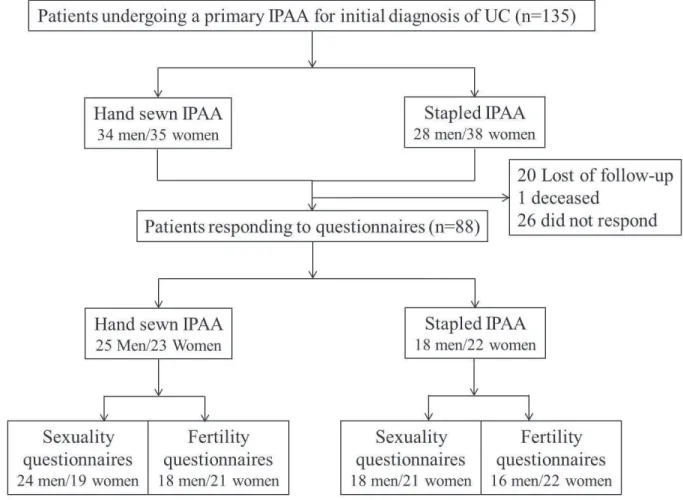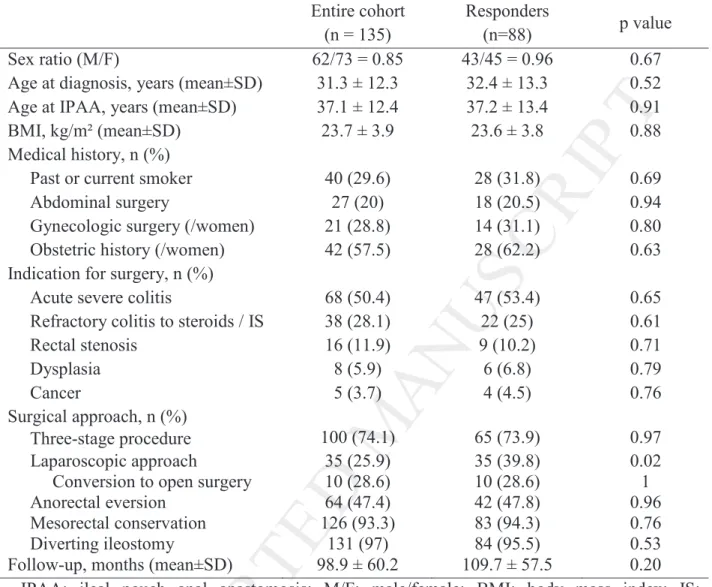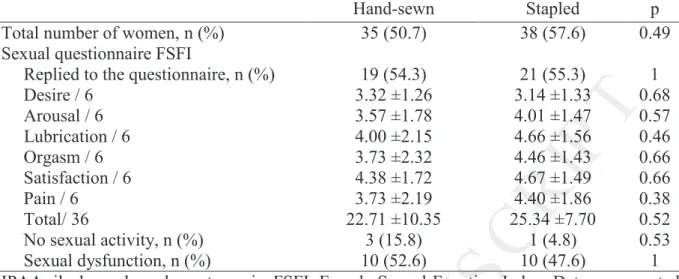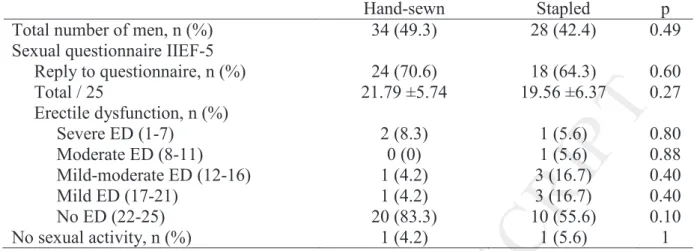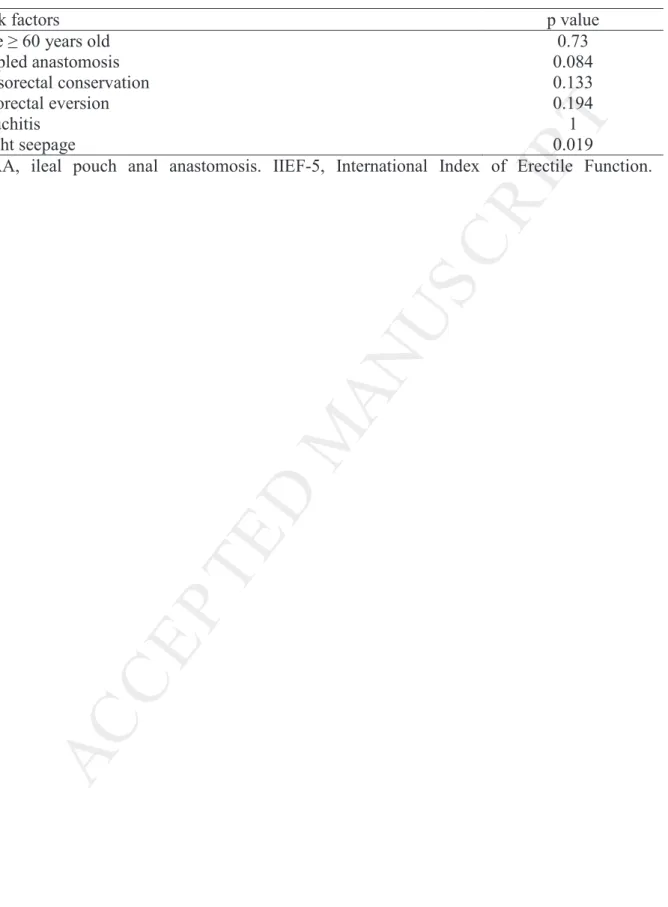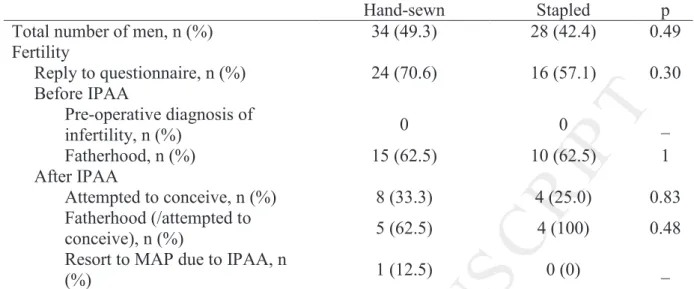HAL Id: hal-01174213
https://hal-univ-rennes1.archives-ouvertes.fr/hal-01174213
Submitted on 22 Sep 2015HAL is a multi-disciplinary open access archive for the deposit and dissemination of sci-entific research documents, whether they are pub-lished or not. The documents may come from teaching and research institutions in France or abroad, or from public or private research centers.
L’archive ouverte pluridisciplinaire HAL, est destinée au dépôt et à la diffusion de documents scientifiques de niveau recherche, publiés ou non, émanant des établissements d’enseignement et de recherche français ou étrangers, des laboratoires publics ou privés.
versus stapled ileal pouch anal anastomosis for
ulcerative colitis
Yann Harnoy, Véronique Desfourneaux, Guillaume Bouguen, Michel Rayar,
Bernard Meunier, Laurent Siproudhis, Karim Boudjema, Laurent Sulpice
To cite this version:
Yann Harnoy, Véronique Desfourneaux, Guillaume Bouguen, Michel Rayar, Bernard Meunier, et al.. Sexuality and fertility outcomes following hand-sewn versus stapled ileal pouch anal anas-tomosis for ulcerative colitis. Journal of Surgical Research, Elsevier, 2016, 200 (1), pp.66-72. �10.1016/j.jss.2015.06.054�. �hal-01174213�
M
A
N
U
S
C
R
IP
T
A
C
C
E
P
T
E
D
ACCEPTED MANUSCRIPT
Sexuality and fertility outcomes following hand-sewn versus stapled ileal pouch anal
anastomosis for ulcerative colitis.
Harnoy Y, MD1, Desfourneaux V, MD1, Bouguen G, MD2,3, Rayar M, MD1, Meunier B,
MD1, Siproudhis L, MD.PhD2, Boudjema K, MD.PhD1,3 and Sulpice L, MD.PhD1,3
1
Service de Chirurgie Hépatobiliaire et Digestive, Hôpital Pontchaillou, Centre Hospitalier
Universitaire, Université de Rennes 1, Rennes, France
2
Service des Maladies de l’Appareil Digestif, Hôpital Pontchaillou, Centre Hospitalier
Universitaire, Université de Rennes 1, Rennes, France
3
INSERM, UMR991. Foie, métabolisme et cancer. Université de Rennes 1, Rennes, France
Running Title: sexuality and fertility outcomes after IPAA Correspondence:
Doctor Laurent Sulpice, Service de Chirurgie Hépatobiliaire et Digestive, Hôpital
Pontchaillou, Centre Hospitalier Universitaire, Université de Rennes 1, Rennes, France.
Telephone: + 33 299 28 42 65 Fax: + 33 299 28 41 29
Email: laurent.sulpice@chu-rennes.fr
Conflicts of interest: The authors have no conflicts of interest to declare Funding: The study received no external support
Author contributions:
YH conceived and designed study, undertook the analysis and interpretation of data, and
wrote and finalized the manuscript. VD, GB, MR collected data and provided the statistical
analysis. BM, LS analyzed and interpreted the data, and revised the manuscript. KB and LS
M
A
N
U
S
C
R
IP
T
A
C
C
E
P
T
E
D
ABSTRACTBackground: Ileal pouch anal anastomosis (IPAA) may alter sexuality and fertility in
women. The laparoscopic approach seems to reduce infertility rates in women after IPAA.
However, the impact of hand-sewn versus stapled IPAA on sexuality and fertility has never
been assessed in patients with ulcerative colitis (UC). The objective of this study was to
analyse the impact of the IPAA technique on sexuality and fertility in UC.
Methods: All UC patients who underwent an IPAA between May 1996 and April 2011 were
included. The patients answered mailed questionnaires including sexuality validated
questionnaires and fertility questionnaires. The risk factors of sexual dysfunction were
explored.
Results: A total of 135 patients were included. Eighty-eight patients (65%) answered the
questionnaires. Their mean age and follow-up were 37.2 ± 13.4 years and 109.7 ± 57.5
months. The rates of female and male sexual dysfunction were 50% and 29%, respectively.
Intestinal transit disorders were identified as risk factors in both men and women, and
anastomotic stricture in women sexual dysfunction, in univariate analyses. The IPAA
technique did not impact sexual function in women but there was a trend for less erectile
dysfunction following hand-sewn IPAA (16.7% vs 44.4%). The fertility rate was 47% in
women and 75% in men, with a trend for a better fertility in women after hand-sewn IPAA
(p=0.07).
Conclusion: In this preliminary study, the hand-sewn or stapled IPAA technique did not
impact the sexuality or fertility outcomes of UC patients, but there was a trend for better
female fertility and male erectile function following hand-sewn IPAA. Intestinal transit
disorders contributed to male and female sexual dysfunction after IPAA.
Keywords: sexuality, fertility, ileal pouch anal anastomosis, proctocolectomy, ulcerative
M
A
N
U
S
C
R
IP
T
A
C
C
E
P
T
E
D
1. INTRODUCTIONUlcerative colitis (UC) is a chronic inflammatory bowel disease (IBD) affecting the mucosa
of the rectum and the colon. Total proctocolectomy is indicated in UC patients for medically
refractory colitis, acute severe colitis, rectal stenosis and colorectal dysplasia or cancer [1].
Restorative proctocolectomy with ileal pouch anal anastomosis (IPAA), was first described by
Parks and Nicholls in 1978 [2], and it is currently the gold standard for the surgical
management of UC patients. IPAA functional outcomes and quality of life (QOL), as well as
post-operative complications (e.g., pouchitis, small bowel obstruction and pouch failure) have
already been extensively studied [3].
Likewise, the type of IPAA, pouch conformation or surgical access have been studied and
compared. Functional outcomes between hand-sewn IPAAs and stapled IPAAs have provided
variable results, mainly depending on the underlying disease and the type of pouch
conformation [4,5]. The ileal J-pouch conformation [6] has been shown to provide better
functional outcomes than the S-pouch conformation, and is easier and more rapid to perform
than the W-pouch conformation [7-12]. Compared to laparotomy, laparoscopic IPAA has
been shown to be associated with fewer long-term complications [13,14] and lower infertility
rates in women [15,16]. Nevertheless, very few studies have focused on the sexuality and
fertility outcomes after IPAA, and none have analysed the impact of the ileo-anal anastomosis
technique.
The objective of the present study was to compare the sexual and fertility outcomes in women
and men afflicted by UC after IPAA with J-pouch conformation, either hand-sewn or stapled.
2. PATIENTS AND METHODS
2.1 Study population
A retrospective analysis from a prospective database was undertaken, including all patients
M
A
N
U
S
C
R
IP
T
A
C
C
E
P
T
E
D
performed at a tertiary colorectal surgery referral centre between 1 May 1996 and 30 April
2011. The study protocol was approved by the institutional review board.
Demographic data included the following: gender, age at UC diagnosis, age, body mass index,
smoking status at the time of IPAA and any medical history that could have impacted the
functional results of IPAA such as abdominal surgery (excluding a prior subtotal colectomy
for acute UC), and gynaecologic or obstetric surgery in women. Perioperative data included
the following: the indication for surgery, i.e., acute severe colitis, refractory colitis to steroids
and/or to immunosuppressant drugs, rectal stenosis, and dysplasia and/or cancer; the type of
surgical approach, i.e., 3-stage procedures, laparoscopic approach, conversion to open
surgery, anorectal eversion, mesorectal conservation, as well as confection of diverting
ileostomy.
Postoperative data included an assessment of mortality at 30 days and post-operative
morbidity.
2.2 Assessment of sexuality and fertility outcomes
To analyze the sexuality and fertility outcomes, questionnaires were sent to patients on 15
April 2013. The Female Sexual Function Index (FSFI) was used to assess the sexual health of
women [17,18] and the International Index of Erectile Function (IIEF-5) was used to assess
the sexual health of men [19]. Fertility questionnaires were sent to all patients (Supplementary
files). For women, the fertility outcome after IPAA was only assessed for those of
childbearing age. The childbearing age was defined as an age cutoff from 15 to 45 years old.
Female sexual dysfunction was defined as an FSFI score 26 [18]. Male sexual dysfunction
was defined as mild to severe erectile dysfunction corresponding to an IEEF-5 score 21
M
A
N
U
S
C
R
IP
T
A
C
C
E
P
T
E
D
Female fertility was defined as the ability to conceive with regular unprotected intercourse
and was confirmed through an ultrasound scan of any on-going or past pregnancies (including
abortions, extra-uterine pregnancies and miscarriages).
Male fertility was defined as the ability to conceive with regular unprotected intercourse and
confirmed by the female partner’s ultrasound scan of any on-going or past pregnancies
(including abortions, extra-uterine pregnancies and miscarriages).
2.3 Surgical techniques
All IPAA operations were performed by senior surgeons following standard procedures
[6,20-23]. Open IPAA was performed through a midline periumbilical incision. Laparoscopic IPAA
was performed using 5 to 6 laparoscopic ports (5-12mm). In both approaches, colon
mobilisation and vascular ligations were performed using standardised techniques and rectal
dissection through the mesorectum was performed close to the rectal wall, preserving pelvic
innervations. Patients with rectal cancer or narrow pelvises underwent total mesorectum
excision (TME). Two distal rectal section techniques were performed depending on the
surgeon’s preferences: intra-abdominal rectal transection to the pelvic floor with an
articulated linear stapler, or anorectal eversion and rectal transection close to the dentate line
with a linear stapler [20]. Ileal pouch construction was always performed using a J-pouch [6],
and stapled through the midline incision for open technique [21] or through the site of the
future ileostomy in the right lower quadrant for the laparoscopic technique. IPAA was either
hand-sewn to the dentate line with one layer of interrupted 4.0 resorbable sutures or stapled
according to the double staple line technique after insertion of a 29-mm circular stapler (EEA,
CDH, PCEA or ILS) through the anus [22]. A pelvic drain was systematically left close to the
anastomosis.
Five patients were operated for an indication of cancer but six patients of the cohort presented
M
A
N
U
S
C
R
IP
T
A
C
C
E
P
T
E
D
rectum (n=3). According to French guidelines for colon and rectum cancer therapy regarding
the TNM classification, none of the patients were excluded from analyses because none
received an adjuvant or neoadjuvant therapy (3, 2 and 1 patients were pTisN0M0R0,
pT2N0M0R0, and pT3N0M0R0, respectively).
2.4 Statistical analysis
Patients with stapled IPAA surgeries were compared to patients with hand-sewn IPAA
surgeries to determine differences in the sexual and fertility outcomes of these patient groups.
Categorical data were reported as percentages. Quantitative variables were reported as mean ±
standard deviation. Categorical data were compared using the Fisher exact test or the
Chi-square test. Quantitative variables were compared using the Mann-Whitney test. The tests
were always 2-sided, and results with a p-value < 0.05 were considered statistically
significant. Data were analysed using the software GraphPadPrism 5 for Windows.
Risk factors for male and female sexual dysfunction were evaluated only through univariate.
A p value < 0.05 was considered statistically significant. Univariate analyses were performed
using the software Statview (SAS) 5.0 version for Windows. The small sample size of the
present cohort did not allow to perform a relevant multivariate analysis.
3. RESULTS
3.1 Demographic and operative data
In the entire cohort, 135 patients underwent a primary IPAA for initial diagnosis of UC within
the 180-month study period. The mean age was 37 ± 12 years. The male/female ratio was 0.85
(62/73). Mean follow-up time was 99 ± 60 months. None patient with a diagnosis of cancer
received a neo-adjuvant or an adjuvant therapy. IPAA procedures were either hand-sewn or
stapled in 69 and 66 patients, respectively. IPAAs were mainly stapled in patients who had
anorectal eversion (78%), and IPAAs were mainly hand-sewn in patients who underwent the
M
A
N
U
S
C
R
IP
T
A
C
C
E
P
T
E
D
As shown in Figure 1 and Table 1, 88 patients (65%) answered the questionnaires. Table 1
reports the comparison of the demographic and operative data of the entire cohort and the
responders to the questionnaires. There were no differences except for the laparoscopic
approach.
In the responder group, a prior colectomy was performed in 65 patients (73.9%). The
laparoscopic approach was performed in 35 cases (39.8%) and conversion to open surgery
was necessary in 10 cases (29%). Total mesorectum excision was performed in 5 cases
(5.7%). Anorectal eversion was performed in 42 cases (47.8%). Temporary diverting
ileostomy was performed routinely. Only 4 patients did not have ileostomy due to technical
difficulties during the surgery.
3.2 Sexual dysfunction and fertility in women
Table 2 reports the results of the FSFI questionnaire completed by the female patients. Forty
women (55%) replied and the mean score was of 24 ± 9. Twenty women (50%) reported
sexual dysfunction (FSFI score 26) including 4 women (10%) with no sexual activity. Five
women returned a blank questionnaire saying that they were too old to engage in sexual
activity (2 cases), or refusing to answer such personal questions (3 cases). The type of
anastomosis had no impact on sexual dysfunction occurrence (table 3). Anastomotic stricture
and intestinal transit disorders (night seepage, stool frequency 5 / day, night pad use) were
identified as risk factors for female dysfunction in univariate analysis.
Forty-three women (59%) replied to the fertility questionnaire (Table 4). Thirty-one (72%)
already had children before the IPAA procedure. After he IPAA procedure, 33 women (77%)
were of childbearing age, 15 (46%) of whom had pregnancy desires and had tried to conceive.
Seven women (50%) became mothers after the IPAA procedure. Two women had to resort to
medically assisted procreation (MAP) after undergoing the IPAA procedure and 1 woman had
M
A
N
U
S
C
R
IP
T
A
C
C
E
P
T
E
D
chosen delivery method for 5 women because their prior IPAA procedure. Regarding female
fertility there was a trend for a better fertility after hand-sewn IPAA (p=0.07, not significant).
3.3 Sexual dysfunction and fertility in men
Table 5 reports the results of the IEEF-5 questionnaire in the male population. Forty-two men
(68%) completed the IIEF-5 questionnaire with a mean score of 21 ± 6. Twelve men (29%)
were evaluated as suffering from moderate to severe erectile dysfunction (IIEF-5 score 21).
In this subgroup, 2 men did not engage in sexual activity. The type of anastomosis had no
impact on sexual dysfunction occurrence and night seepage was the only risk factor of male
sexual dysfunction detected in univariate analysis (p = 0.019; table 6).
Among the 40 men (65%) who replied to the fertility questionnaire (table 7), 25 (63%) were
fathers before undergoing the IPAA procedure. Twelve men (30%) had fatherhood desires
after the IPAA procedures and tried to conceived, and 9 (75%) eventually became fathers.
One man had a successful MAP. Two men with fatherhood desires did not yet have a child
but were not diagnosed with post-operative infertility.
4. DISCUSSION
IPAA is a common surgical procedure in patients with complicated UC. The ileal pouch can
either be hand-sewn or stapled. Little is known about the impact of the IPAA technique on the
patients’ future sexuality and fertility outcomes. The present study analyzed 135 consecutive
IPAA for UC cases with a mean follow-up of 8 years and found that hand-sewing and stapling
the ileal pouch to the anus had similar impacts on fertility and sexuality outcomes in patients
who had undergone IPAA. Validated questionnaires were administered with a response rate of
65%. This response rate corresponds to the usual rate of mail surveys or and may be lower
due to the young age of the study population that partly explain that they are more difficult to
M
A
N
U
S
C
R
IP
T
A
C
C
E
P
T
E
D
The characteristics and perioperative data of the UC patients who underwent IPAA
procedures were similar between the two study groups. However, stapled anastomosis
procedures were more frequently performed by laparotomy and with anorectal eversion than
hand-sewn anastomosis procedures which were mainly performed in laparoscopically
operated patients. However, this may have little impact on patient outcomes because no
difference has been clearly shown between the two techniques.
4.1 Sexuality after IPAA
The FSFI questionnaire [17,18] analyses every aspect of female sexual function and has been
previously used to assess the impact of the IPAA procedure in many studies. The response
rate was high as compared to previous studies of the IPAA impact on female sexuality
[24-27].
In the present study the rate of female sexual dysfunction after IPAA was 50%, results that
were in line with the results previously reported by Ogilvie et al. (47%) [24] and Van Balkom
et al. (50%) [28]. While sexual dysfunction may be related to the risk of nerve damage at the
time of rectal dissection, the close anatomical relationship between the vagina and the pouch
could partly explain the high rates of female sexual dysfunction reported, compared to male
sexual dysfunction.
No difference was found in female sexuality between our two studied groups. Conversely,
Cornish et al. showed that the rate of dyspareunia increased from 8% before to 25% after
IPAA, without any change in sexual satisfaction [29]. These differences may be related to the
fact that a validated questionnaire was used in the present study, restricting the subjectivity of
the answers, especially concerning an intimate domain. As a matter of fact, five women
refused to answer the questionnaire and the fact that it was not anonymous may have had an
M
A
N
U
S
C
R
IP
T
A
C
C
E
P
T
E
D
The current results are similar to previous studies, although the type of anastomosis was not
the main end point for comparison [25-27]. Larson et al. found an average FSFI score of 26.7
after IPAA and did not find a difference between the FSFI score of patients who underwent
laparotomy compared to laparoscopy [25]. Furthermore, female sexual function improved 12
months after the IPAA procedures compared with preoperative status [26]. The FSFI scores
were not different from those of the UC controls [27]. Moreover, no relationship was found
between sexual dysfunction after the IPAA procedure and the fear of anal leakage or pouch
failure [24]. However in the present study, the univariate analysis showed that fear of anal
leakage may have an impact on female sexuality. Compared to the results of the general
healthy population described by Rosen et al. [17], the present authors found a lower overall
FSFI score and lower results in all areas of the female sexual function.
In the male population, the previously validated IIEF-5 questionnaire [19] was used, although
it was an abridged version of the IIEF-15 and analyzed only 1 field of male sexual function,
i.e. the erectile function. Erectile dysfunction was found in 25% of men and was not
associated with the anastomosis technique.
Several studies have analyzed the impact of protectomy and IPAA procedures performed for
IBD on male sexual function. Erectile dysfunction after an IPAA procedure has been
described in 0 to 26% of patients [4,25,26,28,30,31-39] and retrograde ejaculation in 0 to 19%
of patients [33-40]. Five studies [25,26,28,34,41] assessed male sexual function after AIA
using the IIEF-15 questionnaire, which covered five domains: erectile function, orgasm,
sexual desire, intercourse satisfaction and overall satisfaction [42].
In the present study, the presence of faecal seepage at night was the only identified risk factor
for erectile dysfunction. Obviously, this factor may be related to the psychological effect of
night seepage, as observed in women. However one should be aware that the erectile
M
A
N
U
S
C
R
IP
T
A
C
C
E
P
T
E
D
function following hand-sewn IPAA, while it was not significant, may be due to the
preferential use of anorectal eversion in stapled anastomosis in the present study, which may
impair nerve function. However, none of the previous study found this association. The TME
procedure, known to have a risk of nerve injury and erectile dysfunction, and performed in
men for cancer or narrow pelvis in the present study, was not different between the 2 studied
groups.
4.2 Fertility after IPAA
The overall rate of infertility was 53 % of the childbearing age population and who attempted
to conceive. The present findings showed that there was a trend toward better fertility rates in
female patients who underwent the hand-sewn IPAA procedure. However, this observation
may be due to the greater use of laparoscopy in the hand-sewn IPAA group. Indeed, two
recent studies have shown that fertility rates were higher after laparoscopic IPAA procedures
compared to open IPAA procedures [12,13], which may be due to the reduction in scarring
and in intraperitoneal and adnexal adhesions. As a matter of fact, in the current study, 75% of
the male patients who underwent IPAA had normal fertility outcomes, regardless the
anastomosis technique.
4.3 Limitations of the study
As every retrospective study, the present work had some limitations that should be mentioned.
First, a comparison between preoperative and postoperative outcomes might improve the
relevance of our results. Since the beginning of this work, we changed our policy center and
we systematically submitted preoperative and postoperative questionnaires regarding
sexuality and fertility. Second, this study was possibly underpowered regarding the number of
patients who respond to the questionnaires. However, it is a rare pathology, and we stopped
the data collection to assess what the impact was after a 3-year follow-up for the last patients
M
A
N
U
S
C
R
IP
T
A
C
C
E
P
T
E
D
could not been performed, and they need to be confirmed in multicentric study. Third,
hand-sewn anastomosis was mainly performed through a laparoscopic approach and without
anorectal eversion. This might have impacted the results, specifically on fertility in women
regarding previous studies [12, 13]. Moreover, this could explain the trends that more
pregnancies and less erectile dysfunctions were observed following hand-sewn anastomosis,
results which could become significant with larger groups. However, none of the previous
studies have shown that laparoscopic approach or anorectal eversion could impact sexuality,
in men and women, or fertility in men.
In summary, the results of the present preliminary study provide new information on the
functional results of IPAA procedures and especially highlight that the type of IPAA
procedure affects neither the sexuality nor the fertility outcomes in UC patients. However,
there was a trend for better female fertility and erectile function following hand-sewn IPAA.
With a long follow-up period, half of women had sexual dysfunction following the IPAA
procedure. Fear of anal leakage (night seepage) interfered in male and female sexuality
outcomes after the IPAA procedure. Infertility remains high in UC patients after IPAA and
affects more women than men.
LEGENDS OF FIGURES AND TABLES
Figure 1. Distribution of the patients according to the anastomosis technique and to response
to questionnaires
Table 1. Ulcerative colitis patients with ileal pouch anal anastomosis: comparison of the
characteristics of the entire cohort versus the patients responding to the questionnaires
Table 2. Female sexuality after IPAA for ulcerative colitis: a comparison of hand-sewn
M
A
N
U
S
C
R
IP
T
A
C
C
E
P
T
E
D
Table 3. Univariate analyses of risk factors of female sexual dysfunction (score FSFI 26)
after IPAA for ulcerative colitis
Table 4. Female fertility after IPAA for ulcerative colitis: a comparison of hand-sewn versus
stapled IPAA
Table 5. Male sexuality after IPAA for ulcerative colitis: a comparison of hand-sewn versus
stapled IPAA
Table 6. Univariate analyses of risk factors of mild to severe erectile dysfunction (IIEF-5
score 21) after IPAA for ulcerative colitis
Table 7. Male fertility evaluation after IPAA for ulcerative colitis: hand-sewn versus stapled
IPAA
REFERENCES
[1]. Danese S, Fiocchi C. Ulcerative colitis. N Engl J Med 2011;365:1713-25.
[2]. Parks AG, Nicholls RJ. Proctocolectomy without ileostomy for ulcerative colitis. BMJ
1978;2:85-8.
[3]. Fazio VW, Kiran RP, Remzi FH, Coffey C, Heneghan HM, Kirat HT, et al. Ileal pouch
anal anastomosis : analysis of outcome and quality of life in 3707 Patients. Ann Surg
2013;257:679-85.
[4]. Lovegrove RE, Constantinides VA, Heriot AG, Athanasiou T, Darzi A, Remzi FH, et al.
A comparison of hand-sewn versus stapled ileal pouch anal anastomosis (IPAA) following
proctocolectomy: a meta-analysis of 4183 patients. Ann Surg 2006;244:18-26.
[5]. Kirat HT, Remzi FH, Kiran RP, Fazio VW. Comparison of outcomes after handsewn
versus stapled ileal pouch-anal anastomosis in 3,109 patients. Surgery
M
A
N
U
S
C
R
IP
T
A
C
C
E
P
T
E
D
[6]. Utsunomiya J, Iwama T, Imajo M, Matsuo S, Sawai S, Yaegashi K, et al. Total
colectomy, mucosal proctectomy, and ileoanal anastomosis. Dis Colon Rectum
1980;23:459-66.
[7]. Fonkalsrud EW. Total colectomy and endorectal ileal pull-through with internal ileal
reservoir for ulcerative colitis. Surg Gynecol Obstet 1980;150:1-8.
[8]. Nicholls RJ, Lubowski DZ. Restorative proctocolectomy: the four loop (W) reservoir. Br
J Surg 1987;74:564-6.
[9]. Nicholls RJ, Pezim ME. Restorative proctocolectomy with ileal reservoir for ulcerative
colitis and familial adenomatous polyposis: a comparison of three reservoir designs. Br J Surg
1985;72:470-4.
[10]. McGuire BB, Brannigan AE, O’Connell PR. Ileal pouch-anal anastomosis. Br J Surg
2007;94:812-23.
[11]. Lovegrove RE, Heriot AG, Constantinides V, Tilney HS, Darzi AW, Fazio VW, et al.
Meta-analysis of short-term and long-term outcomes of J, W and S ileal reservoirs for
restorative proctocolectomy. Colorectal Dis 2007;9:310-20.
[12]. McCormick PH, Guest GD, Clark AJ, Petersen D, Clark DA, Stevenson AR, et al. The
ideal ileal-pouch design: a long-term randomized control trial of J- vs W-pouch construction.
Dis Colon Rectum 2012;55:1251-7.
[13]. El-Gazzaz GS, Kiran RP, Remzi FH, Hull TL, Geisler DP. Outcomes for case-matched
laparoscopically assisted versus open restorative proctocolectomy. Br J Surg 2009;96:522-6.
[14]. Larson DW, Cima RR, Dozois EJ, Davies M, Piotrowicz K, Barnes SA, et al. Safety,
feasibility, and short-term outcomes of laparoscopic ileal-pouch-anal anastomosis: a single
M
A
N
U
S
C
R
IP
T
A
C
C
E
P
T
E
D
[15]. Bartels SA, D’Hoore A, Cuesta MA, Bensdorp AJ, Lucas C, Bemelman WA.
Significantly increased pregnancy rates after laparoscopic restorative proctocolectomy. Ann
Surg 2012;256:1045-8.
[16]. Beyer-Berjot L, Maggiori L, Birnbaum D, Lefevre JH, Berdah S, Panis Y. A total
laparoscopic approach reduces the infertility rate after ileal pouch-anal anastomosis. Ann Surg
2013;258:275-82.
[17]. Rosen R, Brown C, Heiman J, Leiblum S, Meston C, Shabsigh R, et al. The Female
Sexual Function Index (FSFI): a multidimensional self-report instrument for the assessment of
female sexual function. J Sex Marital Ther 2000;26:191-208.
[18]. Wiegel M, Meston C, Rosen R. The female sexual function index (FSFI):
cross-validation and development of clinical cut-off scores. J Sex Marital Ther 2005;31:1-20.
[19]. Rosen RC, Cappelleri JC, Smith MD, Lipsky J, Peña BM. Development and evaluation
of an abridged, 5-item version of the International Index of Erectile Function (IIEF-5) as a
diagnostic tool for erectile dysfunction. Int J Impot Res 1999;11:319-26.
[20]. Goligher JC. Eversion technique for distal mucosal proctectomy in ulcerative colitis. A
preliminary report. Br J Surg 1984;71:26-8.
[21]. Heald RJ, Allen DR. Stapled ileo-anal anastomosis: a technique to avoid mucosal
proctectomy in the ileal pouch operation. Br J Surg 1986;73:571-2.
[22]. Hughes JP, Bauer AR, Bauer CM. Stapling techniques for easy construction of an ileal
J-pouch. Am J Surg 1988;155:783-5.
[23]. Thirlby RC. Optimizing results and techniques of mesenteric lengthening in ileal
pouch-anal anastomosis. Am J Surg 1995;169:499-502.
[24]. Ogilvie JW Jr, Goetz L, Baxter NN, Park J, Minami S, Madoff RD. Female sexual
M
A
N
U
S
C
R
IP
T
A
C
C
E
P
T
E
D
[25]. Larson DW, Davies DM, Dozois EJ, Cima RR, Piotrowicz K, Anderson K, et al. Sexual
function, body image and quality of life after laparoscopic and open ileal pouch-anal
anastomosis. Dis Colon Rectum 2008;51:392-6.
[26]. Davies RJ, O’Connor BI, Victor C, Macrae HM, Cohen Z, McLeod RS. A prospective
evaluation of sexual function and quality of life after ileal pouch-anal anastomosis. Dis Colon
Rectum 2008;51:1032-5.
[27]. Cornish J, Wooding K, Tan E, Nicholls RJ, Clark SK, Tekkis PP. Study of Sexual,
Urinary, and Fecal Function in Females Following Restorative Proctocolectomy. Inflamm
Bowel Dis 2012;18:1601-7.
[28]. Van Balkom KA, Beld MP, Visschers RG, van Gemert WG, Breukink SO. Long-term
results after restorative proctocolectomy with ileal pouch-anal anastomosis at a young age.
Dis Colon Rectum 2012;55:939-47.
[29]. Cornish JA, Tan E, Teare J, Teoh TG, Rai R, Darzi AW, et al. The effect of restorative
proctocolectomy on sexual function, urinary function, fertility, pregnancy and delivery: a
systematic review. Dis Colon Rectum 2007;50:1128-38.
[30]. Marcello PW, Roberts PL, Schoetz DJ Jr, Coller JA, Murray JJ, Veidenheimer MC.
Long-term results of the ileoanal pouch procedure. Arch Surg 1993;128:500-3; discussion
503-4.
[31]. Tiainen J, Matikainen M, Hiltunen KM. Ileal J-pouch–anal anastomosis, sexual
dysfunction, and fertility. Scand J Gastroenterol 1999;34:185-8.
[32]. Hueting WE, Gooszen HG, van Laarhoven CJ. Sexual function and continence after ileo
pouch anal anastomosis: a comparison between a meta-analysis and a questionnaire survey.
Int J Colorectal Dis 2004;19:215-8.
[33]. Damgaard B, Wettergren A, Kirkegaard P. Social and sexual function following ileal
M
A
N
U
S
C
R
IP
T
A
C
C
E
P
T
E
D
[34]. Gorgun E, Remzi FH, Montague DK, Connor JT, O’Brien K, Loparo B, et al. Male
sexual function improves after ileal pouch anal anastomosis. Colorectal Dis 2005;7:545-50.
[35]. Slors FJ, Van Zuijlen PP, Van Dijk GJ. Sexual and bladder dysfunction after total
mesorectal excision for benign diseases. Scand J Gastroenterol Suppl 2000;232:48-51.
[36]. Michelassi F, Stella M, Block GE. Prospective assessment of functional results after
ileal J pouch-anal restorative proctocolectomy. Arch Surg 1993;128:889-94;discussion 894-5.
[37]. Lindsey I, George BD, Kettlewell MG, Mortensen NJ. Impotence after mesorectal and
close rectal dissection for inflammatory bowel disease. Dis Colon Rectum 2001;44:831-5.
[38]. Yeager ES, Van Heerden JA. Sexual dysfunction following proctocolectomy and
abdominoperineal resection. Ann Surg 1980;191:169-70.
[39]. Bauer JJ, Gelernt IM, Salky B, Kreel I. Sexual dysfunction following proctocolectomy
for benign disease of the colon and rectum. Ann Surg 1983;197:363-7.
[40]. Polle SW, Dunker MS, Slors JF, Sprangers MA, Cuesta MA, Gouma DJ, et al. Body
image, cosmesis, quality of life, and functionnal outcomes of hand-assisted laparoscopic
versus open restorative proctocolectomy: long-term results of a randomized trial. Surg Endosc
2007;21:1301-7.
[41]. Bengtsson J, Lindholm E, Nordgren S, Berndtsson I, Oresland T, Borjesson L. Sexual
function after failed ileal pouch-anal anastomosis. J Crohns Colitis 2011;5:407-14.
[42]. Rosen RC, Riley A, Wagner G, Osterloh IH, Kirkpatrick J, Mishra A. The international
index of erectile function (IIEF): a multidimensional scale for assessment of erectile
M
A
N
U
S
C
R
IP
T
A
C
C
E
P
T
E
D
Figure 1. Distribution of the patients according to the anastomosis technique and to
M
A
N
U
S
C
R
IP
T
A
C
C
E
P
T
E
D
Table 1. Ulcerative colitis patients with ileal pouch anal anastomosis: comparison of the
characteristics of the entire cohort versus the patients responding to the questionnaires
Entire cohort (n = 135)
Responders
(n=88) p value Sex ratio (M/F) 62/73 = 0.85 43/45 = 0.96 0.67 Age at diagnosis, years (mean±SD) 31.3 ± 12.3 32.4 ± 13.3 0.52 Age at IPAA, years (mean±SD) 37.1 ± 12.4 37.2 ± 13.4 0.91 BMI, kg/m² (mean±SD) 23.7 ± 3.9 23.6 ± 3.8 0.88 Medical history, n (%)
Past or current smoker 40 (29.6) 28 (31.8) 0.69 Abdominal surgery 27 (20) 18 (20.5) 0.94 Gynecologic surgery (/women) 21 (28.8) 14 (31.1) 0.80 Obstetric history (/women) 42 (57.5) 28 (62.2) 0.63 Indication for surgery, n (%)
Acute severe colitis 68 (50.4) 47 (53.4) 0.65 Refractory colitis to steroids / IS 38 (28.1) 22 (25) 0.61 Rectal stenosis 16 (11.9) 9 (10.2) 0.71 Dysplasia 8 (5.9) 6 (6.8) 0.79 Cancer 5 (3.7) 4 (4.5) 0.76 Surgical approach, n (%) Three-stage procedure 100 (74.1) 65 (73.9) 0.97 Laparoscopic approach 35 (25.9) 35 (39.8) 0.02 Conversion to open surgery 10 (28.6) 10 (28.6) 1 Anorectal eversion 64 (47.4) 42 (47.8) 0.96 Mesorectal conservation 126 (93.3) 83 (94.3) 0.76 Diverting ileostomy 131 (97) 84 (95.5) 0.53 Follow-up, months (mean±SD) 98.9 ± 60.2 109.7 ± 57.5 0.20
IPAA: ileal pouch anal anastomosis; M/F: male/female; BMI: body mass index; IS:
M
A
N
U
S
C
R
IP
T
A
C
C
E
P
T
E
D
Table 2. Female sexuality after IPAA for ulcerative colitis: a comparison of hand-sewn
versus stapled IPAA
Hand-sewn Stapled p Total number of women, n (%) 35 (50.7) 38 (57.6) 0.49 Sexual questionnaire FSFI
Replied to the questionnaire, n (%) 19 (54.3) 21 (55.3) 1 Desire / 6 3.32 ±1.26 3.14 ±1.33 0.68 Arousal / 6 3.57 ±1.78 4.01 ±1.47 0.57 Lubrication / 6 4.00 ±2.15 4.66 ±1.56 0.46 Orgasm / 6 3.73 ±2.32 4.46 ±1.43 0.66 Satisfaction / 6 4.38 ±1.72 4.67 ±1.49 0.66 Pain / 6 3.73 ±2.19 4.40 ±1.86 0.38 Total/ 36 22.71 ±10.35 25.34 ±7.70 0.52 No sexual activity, n (%) 3 (15.8) 1 (4.8) 0.53 Sexual dysfunction, n (%) 10 (52.6) 10 (47.6) 1 IPAA, ileal pouch anal anastomosis. FSFI, Female Sexual Function Index. Data are reported
M
A
N
U
S
C
R
IP
T
A
C
C
E
P
T
E
D
Table 3. Univariate analyses of risk factors of female sexual dysfunction (score FSFI
26) after IPAA for ulcerative colitis
Risk factors p value
Age 60 years-old 0.56
Stapled anastomosis 1
Anorectal eversion 0.20
Anastomotic stricture 0.032
Night seepage 0.011
Stool frequency 5 / day 0.048
Night pad use 0.004
M
A
N
U
S
C
R
IP
T
A
C
C
E
P
T
E
D
Table 4. Female fertility after IPAA for ulcerative colitis: a comparison of hand-sewn
versus stapled IPAA
Hand-sewn Stapled p Total number of women, n (%) 35 (50.7) 38 (57.6) 0.49 Fertility
Reply to questionnaire, n (%) 21 (60.0) 22 (57.9) 1 Before IPAA
Pre-operative diagnosis of infertility, n (%) 0 0 _ Maternity, n (%) 14 (66.7) 17 (77.3) 0.51 After IPAA Childbearing age, n (%) 14 (66.7) 19 (86.4) 0.24 Pregnancy desire, n (%) 8 (57.1) 7 (36.8) 0.30 Attempted to conceive, n (%) 8 (57.1) 7 (36.8) 0.30 Pregnancy, n (%) 6 (75) 1 (14.3) 0.07 Resort to MAP due to IPAA, n (%) 1 (12.5) 1 (14.3) 0.51 C-section delivery method, n (%) 4 (66.7) 1 (100) 0.61 IPAA, ileal pouch anal anastomosis. MAP, medically assisted procreation. Data are reported
M
A
N
U
S
C
R
IP
T
A
C
C
E
P
T
E
D
Table 5. Male sexuality after IPAA for ulcerative colitis: a comparison of hand-sewn
versus stapled IPAA
Hand-sewn Stapled p Total number of men, n (%) 34 (49.3) 28 (42.4) 0.49 Sexual questionnaire IIEF-5
Reply to questionnaire, n (%) 24 (70.6) 18 (64.3) 0.60 Total / 25 21.79 ±5.74 19.56 ±6.37 0.27 Erectile dysfunction, n (%) Severe ED (1-7) 2 (8.3) 1 (5.6) 0.80 Moderate ED (8-11) 0 (0) 1 (5.6) 0.88 Mild-moderate ED (12-16) 1 (4.2) 3 (16.7) 0.40 Mild ED (17-21) 1 (4.2) 3 (16.7) 0.40 No ED (22-25) 20 (83.3) 10 (55.6) 0.10 No sexual activity, n (%) 1 (4.2) 1 (5.6) 1 IPAA, ileal pouch anal anastomosis. IIEF-5, International Index of Erectile Function. ED,
erectile dysfunction. Data are reported as the number of patients (percentage of patients) and
M
A
N
U
S
C
R
IP
T
A
C
C
E
P
T
E
D
Table 6. Univariate analyses of risk factors of mild to severe erectile dysfunction (IIEF-5
score 21) after IPAA for ulcerative colitis
Risk factors p value
Age 60 years old 0.73
Stapled anastomosis 0.084
Mesorectal conservation 0.133
Anorectal eversion 0.194
Pouchitis 1
Night seepage 0.019
M
A
N
U
S
C
R
IP
T
A
C
C
E
P
T
E
D
Table 7. Male fertility evaluation after IPAA for ulcerative colitis: hand-sewn versus
stapled IPAA
Hand-sewn Stapled p Total number of men, n (%) 34 (49.3) 28 (42.4) 0.49 Fertility Reply to questionnaire, n (%) 24 (70.6) 16 (57.1) 0.30 Before IPAA Pre-operative diagnosis of infertility, n (%) 0 0 _ Fatherhood, n (%) 15 (62.5) 10 (62.5) 1 After IPAA Attempted to conceive, n (%) 8 (33.3) 4 (25.0) 0.83 Fatherhood (/attempted to conceive), n (%) 5 (62.5) 4 (100) 0.48 Resort to MAP due to IPAA, n
(%) 1 (12.5) 0 (0) _
IPAA, ileal pouch anal anastomosis. MAP, medically assisted procreation. Data are reported
M
A
N
U
S
C
R
IP
T
A
C
C
E
P
T
E
D
SUPPLEMENTARY FILES:Supplementary file 1. Male Fertility Questionnaire.
1. Fatherhood desire
Before IPAA procedure? YES NO
After IPAA procedure? YES NO
Today? YES NO
A. If yes, did you attempt to conceive children since IPAA? YES NO
B. If yes, have you had difficulties conceiving a child? YES NO
If yes, why? ………
C. If yes, are you in a Medically Assisted Procreation Program? YES NO
If yes, which one and where?
2. Did you have children before the IPAA procedure? YES NO
If yes, how many children have you had? ………
What are their birthdays? ………
If no, was it due to an infertility diagnosis? YES NO
3. Have you had children since the IPAA procedure? YES NO
If yes, how many children have you had? ………
What are their birthdays? ………
If no, was it due to an infertility diagnosis? YES NO
4. If you had a child since the IPAA procedure, did you have to resort to a MAP program?
YES NO
M
A
N
U
S
C
R
IP
T
A
C
C
E
P
T
E
D
Supplementary file 2. Female Fertility Questionnaire
1. Pregnancy desire
Before IPAA procedure? YES NO
After IPAA procedure? YES NO
Today? YES NO
A. If yes, did you attempt to conceive children since IPAA? YES NO
B. If yes, have you had difficulties conceiving a child? YES NO
If yes, why? ………
C. If yes, are you in a Medically Assisted Procreation Program? YES NO
If yes, which one and where? ...
2. Did you have a pregnancy before the IPAA procedure? YES NO
A. If yes, how many pregnancies and children did you have? ………
B. If yes, could you complete the following?
Pregnancy 1st 2nd 3rd 4th 5th 6th Childbirth? Abortion? Miscarriage? Extra-uterine pregnancy? Delivery date / / / / / / / / / / / / On-going pregnancy? Unique pregnancy?
Gemellar pregnancy (or more)? Vaginal delivery?
C section delivery? Episiotomy? Forceps use?
C. If no, was it due to an infertility diagnosis? YES NO
3. Have you had a pregnancy since the IPAA procedure? YES NO
M
A
N
U
S
C
R
IP
T
A
C
C
E
P
T
E
D
B. If yes, could you complete the following table?
Pregnancy 1st 2nd 3rd 4th 5th 6th Childbirth ? Abortion ? Miscarriage ? Extra-uterine pregnancy ? Delivery date / / / / / / / / / / / / Ongoing pregnancy ? Unique pregnancy ?
Gemellar pregnancy (or more) ? Vaginal delivery ?
C section delivery ? Episiotomy ? Forceps use ?
C. If no, was it due to an infertility diagnosis? YES NO
4. If you had a child since the IPAA procedure, did you have to resort to a MAP program?
YES NO
If yes, what was the technique? ………
5. If you have had children since IPAA, did you feel a functional change after delivery
in:
- Urinary emission YES NO
- Faecal emission YES NO
- Sexuality YES NO
- Vaginal pain YES NO
- Perianal pain YES NO
